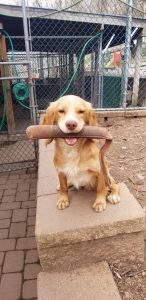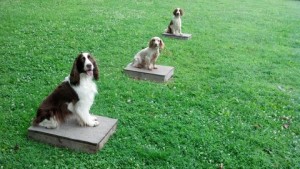STARTING YOUR PUP FOR FIELD WORK
Before sending your dog out for professional training, you can save both time and money if you follow the outlines I have developed for starting your pup properly.
And remember, consistent training in small doses is the key! – Joe
PUPPY TRAINING OUTLINE FIRST SIX MONTHS
by Joe DeMarkis
10 minute sessions as often as possible. Keep these sessions “playful”. Also keep in mind these are just guide-lines. All dogs learn at a different pace. Be mindful not to bore or put pressure on your puppy.
– Sit to hand signal. Start with food bowl
– Introduction to lead. “Not training to heel”. Use a slip lead
– Recall by name. Occasionally recall when exercising
– Recall by whistle. Four sharp pips as soon as dog responds to name
– Retrieve to hand. Use a soft dummy (sock). Recall with whistle. Run back if necessary. One or two per day
– Introduction to cover. Simple obstacles
COMMANDS TO START WITH
Do not over use commands. Instead use the command one time and reinforce it by teaching the dog what you are looking for. Timing is important!
– “Kennel”. Never throw pup in; take gently by scruff and drag repeating kennel. On releasing from kennel, say “Kennel, ‘good boy’ Kennel”
– “Leave it”. Let pup investigate everything but not dwell on a certain spot
– “No”. Use with quiet, leave it and by itself
– “Hup”. Sit
– “Quiet”. Stop making noise
PUPPY TRAINING OUTLINE 6 TO 8 MONTHS
by Joe DeMarkis
– Quartering. Into the wind only! About 10 minutes; understand the wind and your movements. Do not blow the whistle for the sake of blowing the whistle. If dog lines, recall and cast
– Retrieving. One or two retrieves per day
– Introduction to water. Take pups for walks along shallow ponds. Cross a shallow stream. Do not steady dog at water
– Introduction to Game. At about 6 month and some times sooner depending on the dog and its retrieve, I will let the dog find some cold game. If puppy ignores this or is uninterested in hunting, I will encourage it to chase clip wing pigeons as needed
– Start with Pre-Steadying.
Field Commands
VOICE |
RESPONSE |
| Hup | Stop, Sit, Stay |
| Here | Return to heel or attention |
| Dog’s Name | Release to retrieve marked object |
| Leave It | Ignore something unwanted |
| Dead | Hunt for unseen shot game |
| Get On | Start to hunt |
| Over | Move left or right |
| Back | Go out further |
WHISTLE |
RESPONSE |
| 1 Long pip | Stop, Sit, Stay |
| 2 pips | Turn direction |
| 4 Sharp pips | Come in |
HAND |
RESPONSE |
| 1 hand raised in ar | Stop, Sit, Stay |
| Outstretched hand | Move in direction of hand |
| Tap thigh | Come in |
INTRODUCTION TO GUNFIRE
by Joe DeMarkis
Check each box as your pup learns the exercise
Start by introducing your pup to as many noises as possible from an early age. I do not recommend that your dog be shot over until they are around eight months old. There inner ear is still developing up until then.
Do not take this process lightly. This is just an introduction and care should be taken until your pup thoroughly understands the relationship between gunfire and game. The first shots you fire should be in the middle of a wide open field away from a tree line.
A. Before you fire a shot
1. By now your pup should have been introduced to a lot of different noises, been shown many types of cover, has had a retrieve or two of cold game, has a good quartering pattern started and is happy to make a retrieve.
2. Start by letting your pup hear gunfire at no less than 200 yards during a training session, while they are crated in a vehicle. The first time you do this, observe the puppy carefully and do not say anything. After the gunfire is over take the pup out to investigate, smell the scents and have a run.
Do this a least 6 times
B. Next
While the pup is running through cover, and is at least 4 casts in front of you, take a .22 crimp starter pistol, stick it in a game bag that is hanging behind your back and snap off a shot. Watch the dogs’ reaction, do not say anything and continue quartering the pup. Do this only once per day for 5 days
C. Next
Hup your pup at your side, kneel down a lightly restrain him. Have a helper walk out 50 yards with a bumper, face you and throw the bumper in the air, making sure the pup sees the throw. Send the pup for the retrieve
D. Next. Do this only once per session
1. Repeat Step C at the same distance this time having your helper fire the .22 crimp in the air as he throws the bumper.
2. Repeat Step C this time firing the .22 before the bumper is thrown
E. Next
Once the pup is anticipating the retrieve after the snap shot, repeat Step C firing a low caliber, low brass shot from a shotgun at the same distance
Some Common Questions
Q. How do I stop my dog from making noise?
A. Be careful not to reward the dog when making noise. Teaching the dog to relax can help this problem.
Q. What is free feeding?
A. Free feeding is making food available for the dog at all times
Q. Is free feeding a good idea?
A. I do not free feed. Food is a powerful motivator and I use it as part of my training
Q. Where should I feed my dog?
A. Since food is a valuable training tool, we feed in the crate. At feeding time our dogs hop into their crate and wait for their dinner to be delivered
Q. How many times a day should I feed.
A. Puppies, 3 xs’s a day, adults, 2x’s a day
Q. How do I stop my dog from bolting out the door?
A. Teach the dog to sit and then walk behind you go through a doorway
Q. What tools should I have to help me train my dog
A. Crate, lead, training collar, whistle
Q. Should I teach my dog to stay in a crate
A. Absolutely!!! This is a safe haven for your pet. This is where he will learn to relax.
Q. My dog is in the house with me. Do I still need to use a crate?
A. Absolutely!!! It will help him settle.
Q. What type of lead and training collar should I use?
A. I use a British style Slip Lead. I also like a pinch collar attached to a 6’ lead especially for powerful dogs
Q. What is a flex lead.
A. This is a retractable lead that allows the dog to move away from the handler longer distances
Q. Do you use a Flex lead
A. No. I like my dog at my side when on lead and I believe this lead confuses the command of “Heel”
Q. How do you use a whistle in training?
A. I use a whistle to deliver commands when I am working dogs in the field
Q. What type of whistle do you use?
A. I like an Acme British style 211 1/2. This delivers a variety of tones easily
Q. What are the biggest problems you work with as a trainer
A. In general , the answer to this is disobedience
Q. My dog does not listen to commands. What should I do?
A. Train him
Q. I am going to train my dog for hunting. How do I start him
A. Go to the F.A.Q. Page on my web site. There you will find my starting program
Q. What are the biggest problems you work with training a gun dog
A. Gun nervousness and retrieving issues
Q. What is gun nervousness ?
A. This is usually created by the owner. The dog does not understand that the sound of a gun is part of the hunt
Q. How can I avoid Gun Nervousness?
A. Go to the F.A.Q. Page on my web site. There you will find my starting program
Q. My dog will not bring things back to me. How do I train him?
A. This is caused by not properly developing his retrieve. If it is a pup go to F.A.Q. Page on my web site. There you will find my starting program
If it is an adult dog, you must teach the dog to first recall, then hold, then recall and hold
Q. I am thinking of getting a Pup. Should I get 2 to keep each other occupied?
A. NO!!!! Two pups at the same time is a formula for problems
Q. I am told they will keep each other occupied
A. That they will and it will be very difficult to get them to pay attention to you
Q. A breeder I know keeps 2 dogs out of each litter she breeds. Why?
A. Breeders will sometimes keep 2 pups and grow them a bit to see which one fits their program the best. Then sells the one they feel does not make the best fit
Q. Should I consider buying an older dog?
A. Absolutely!!! In most cases a good breeder has socialized and done the basic training
Q. Will an older dog bond to me?
A. Yes. Feed them, train them and love them. That’s all a dog wants
Q. I am looking at getting a hunting dog. What is a started dog?
A. This is a dog that has had basic hunt training
Q. What should I expect out of a started dog?
A. A good response to basic commands needed for that particular breed.
Q. What is a finished dog?
A. A finished dog should be well polished in his performance. Steady with a reliable recall and retrieve

